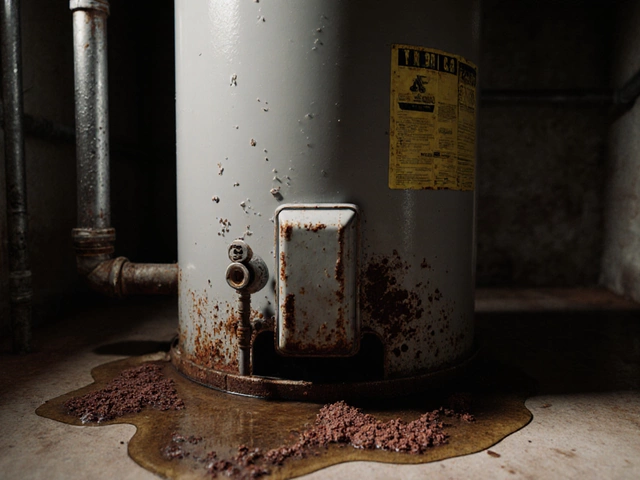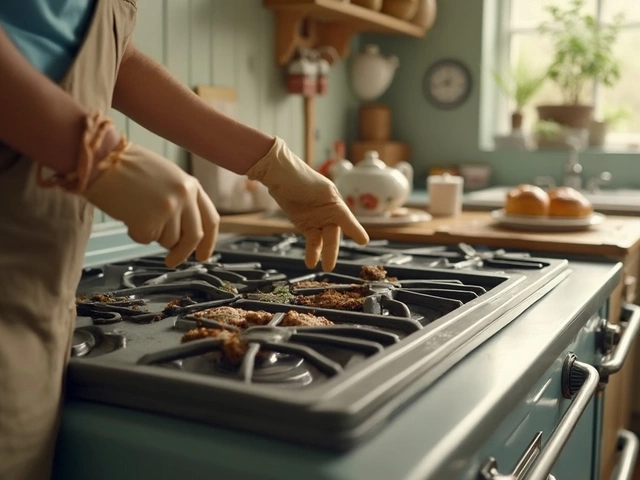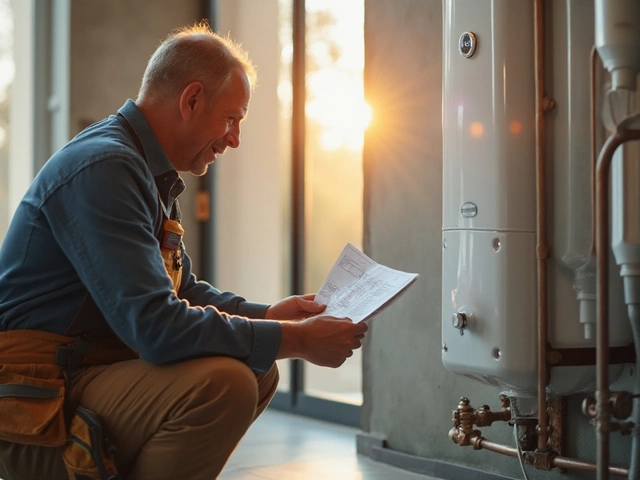Nothing jolts you to your senses quite like a cold shower when you were expecting a steamy escape. Hot water running cold is a common problem that can turn delightful baths into shivering experiences. Let’s dive into why this happens and how you can bring warmth back to your daily routine.
Several reasons might be behind lukewarm or cold water issues, from simple thermostat missettings to more complex issues like sediment build-up in the tank. Thankfully, understanding these problems can pave the way to practical solutions. Whether you're dealing with a gas or electric water heater, the right knowledge can often help you troubleshoot and sometimes even fix the issue on your own.
- Common Causes of Cold Hot Water
- Troubleshooting Steps for Homeowners
- DIY Solutions to Common Problems
- When to Call a Professional
- Maintenance Tips for a Consistent Hot Water Supply
Common Causes of Cold Hot Water
Imagine eagerly stepping into your shower, expecting a cascade of warm water to wash away your day's concerns. Instead, a blast of icy discomfort envelops you. It's perplexing, isn't it? A hot water system failing to deliver hot water can stem from various common factors. One prominent culprit could be a malfunctioning thermostat. A thermostat regulates water temperature, and if it's improperly set or faulty, it could lead to an unexpected chilling effect. Many people overlook this mundane device that quietly governs the warmth of their water.
Another significant factor might be sediment accumulation in your water tank. If a tank sits idle for long without proper maintenance, minerals in the water, like calcium and magnesium, can settle. This sediment can blanket the heating element, significantly decreasing its efficiency. This is particularly common in places with hard water, notorious for its mineral-rich composition. If you've noticed lukewarm water, sediment might well be your adversary.
For those with electric water heaters, a faulty heating element might be to blame. Such units generally utilize two elements, and if one quits its job, your heater might struggle to reach the right temperature. Gas water heaters, on the other hand, have their unique set of issues that could include problems with the pilot light or gas supply. Should these be obstructed, your heater might run but won't heat the water as intended, leaving you with a chilly surprise.
"Water heating represents about 18% of total home energy use," notes the U.S. Department of Energy, emphasizing the importance of energy-efficient systems.
Of course, a simplistic solution could also be an underlying cause. Take a moment to consider the size of your water heater. If you're regularly running out of hot water, it's possible that it's simply too small for your household's needs, unable to maintain supply for consecutive showers or multiple appliances. Conduct a quick assessment of your home's hot water usage to see if a bigger model could resolve your cold spells at home.
Finally, there exists the potential of a leaking water tank. Any breach, no matter how minuscule, can dilute the heated water with cold water from outside, resulting in those unwanted icy encounters. Keep an eye out for visible water pooling near your heater as an indicator of such issues.
The next time your hot water turns cold, you might just be equipped with the knowledge to name the culprit, and maybe even tackle it yourself. Remember, regular maintenance can stave off many of these problems and keep your home comfortably warm all year round.
Troubleshooting Steps for Homeowners
When your shower sends icy cold water cascading instead of the comforting warmth you expected, it’s time to roll up your sleeves and start investigating. The quest for consistent hot water starts with some initial troubleshooting steps that homeowners can easily undertake. Begin your detective work by checking the thermostat on your heater. This device is often the gatekeeper of your ideal hot water temperature. Misadjustments can subtly sneak in, leaving you shivering mid-shower. Ensure it's set to a comfortable 120 degrees Fahrenheit — a sweet spot recommended by many energy experts for balancing efficiency and comfort.
Next on the checklist is determining if power or gas supply interruptions could be at fault. Electric water heaters require a steady power supply. Confirm that the circuit breaker hasn't tripped and that the switch hasn’t been turned off accidentally. For those with gas water heaters, a clear indicator of trouble might be the pilot light. If it's out, you’ll want to carefully follow the manufacturer’s instructions to relight it, staying aware of gas safety protocols.
"Many homeowners can resolve hot water issues with simple adjustments and checks," advises Alan Bedford, a plumbing expert with decades of experience. "Understanding your system is key to maintaining optimal performance."
Typically, sediment build-up is a lesser-known culprit causing cold water woes. Over time, minerals in hard water settle at the bottom of the tank, creating an insulating barrier between the heating element and the water. This build-up can significantly affect efficiency and water temperature. Flushing the tank is a maintenance ritual you can perform to ward off this silent troublemaker. This process might sound daunting, but it’s quite straightforward: shutting off water and power, hooking up a garden hose, and draining the tank until it runs clear. For gas units, don’t forget to reignite the pilot light before you wrap up.
Additionally, inspect your unit for leaking pipes or pooling water around the heater's base. Leaks not only lead to inefficient heating but can also hint at more severe structural problems. Should your examination reveal leaks, it’s essential to address them promptly to prevent further damage and loss of efficiency. While some installations venture might call for professional help, tightening fittings or replacing minor parts can sometimes resolve smaller leaks.
Consider the unit's age in your troubleshooting venture. Water heaters over a decade old are likely to face issues more frequently and might be candidates for replacement rather than repair. Modern water heaters boast better efficiency and technology, making upgrading a financial consideration worth pondering. A new unit, while a financial investment, can offer you years of dependable service and lower energy costs in the long run.
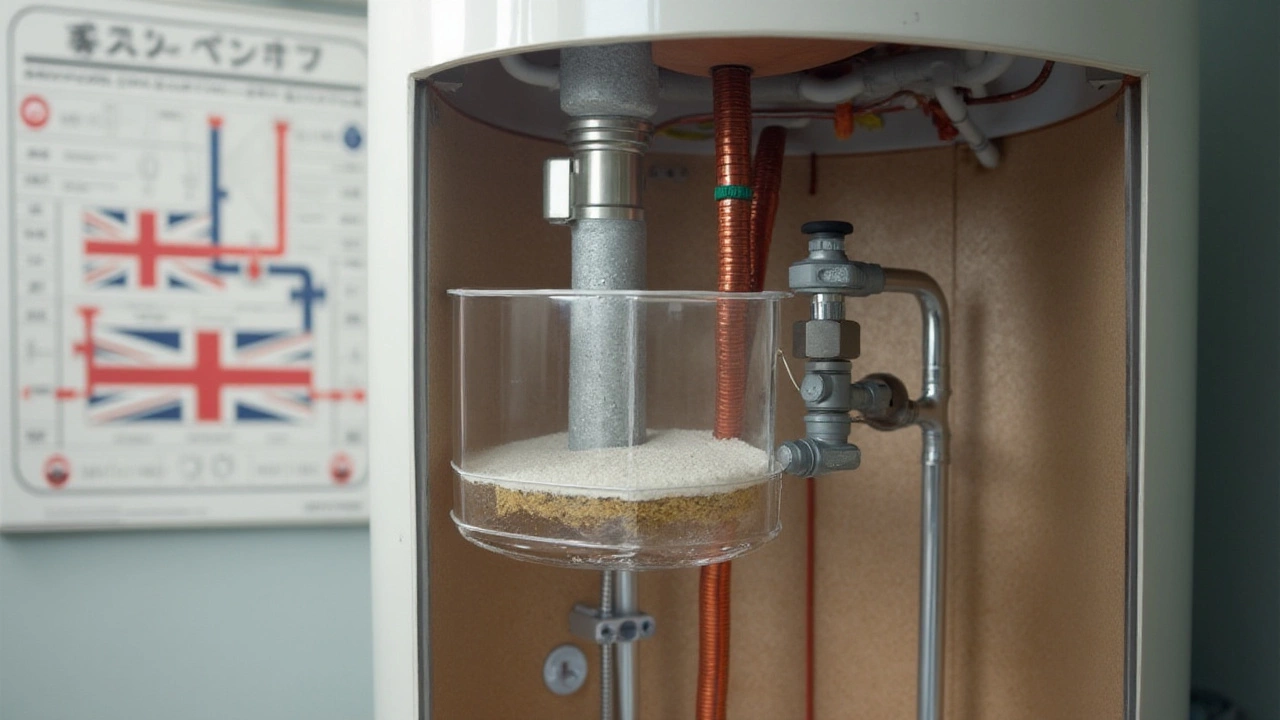
DIY Solutions to Common Problems
Tackling the hot water issues holding your household hostage doesn't always require a toolbox brimming with professional gadgets. More often than not, a good chunk of the problems are solvable with minimal tools and a bit of elbow grease. Let's explore how you can remedy these nuisances effectively right from the comfort of your home.
Your first step often begins with the thermostat. If you're suddenly saddled with a cold shower, it might be your thermostat playing tricks. Checking the settings on the thermostat should be your go-to move. Ensure the thermostat is set to a temperature of around 120 degrees Fahrenheit (about 49 degrees Celsius), a level recommended for both comfort and safety. A blast of hot water that could scald isn't ideal either. Sometimes just readjusting the thermostat can restore the warmth you yearn for.
Sediment buildup is another frequent culprit. Water heaters can accumulate sediment over time, especially in areas with hard water, causing them to function inefficiently. This sediment layer acts like an insulator, keeping the water heater from effectively heating the water. Flushing your water heater every six months or so keeps this problem at bay. To do it, safely turn off the power supply, attach a hose to the drain valve, and direct it to a safe area where the hot water can flow without harming anything. Open the valve and let the water pour out carrying all that pesky sediment along with it. This simple routine can improve the efficiency of your system significantly.
Another frequent issue might lie with the dip tube. This piece of plastic is meant to guide cold water to the bottom of the tank where it can be heated properly. If it breaks, cold water mixes prematurely with the hot water, leading to less than satisfactory temperatures. A simple inspection might reveal cracks or breaks that, when replaced, could restore the harmony of your hot water delivery.
According to The Department of Energy, “Regularly maintaining and flushing your water heater could increase its lifespan and improve energy efficiency.”
Sometimes the circuit breaker might have culprits hiding in plain sight. Check if the breaker might have tripped due to heavy electricity use elsewhere in the home. Resetting it can be a quick fix and if trips are frequent, then it might signal a deeper electrical problem needing professional attention. It's advisable to always handle anything electrical with caution to avoid any mishaps.
For those with gas water heaters, pilot lights going out is an annoyance known greatly. Re-lighting the pilot light following the manufacturer's guidelines can restore hot water swiftly. In recent days, ensuring the thermocouple doesn’t misalign, or accrue dust is also key. This component senses the pilot flame and should remain free from dust and properly aligned to function efficiently.
Apart from a DIY repair, consider insulating your water heater and the pipes surrounding them. This action can prevent heat loss, making your system more effective. It doesn't necessarily fix immediate cold water issues, but boosts long-term efficiency significantly. Keep exploring and gaining skills to resolve minor issues adeptly.
When to Call a Professional
Picture this: you've tried all the troubleshooting steps within your grasp, tinkered with knobs, flipped switches, and maybe even cleaned out a few filters, yet the issue persists. When your hot water is determined to remain cold, it might be time to call in a professional. Many common hot water issues trace back to problems within the heating elements or the internal mechanics of the unit — areas best left to trained experts. For instance, if your water heater is making odd noises, the root cause could be a thick layer of sediment impacting the heating element, which may require specialized tools and expertise to resolve effectively.
Beyond apparent mechanical failures, another red flag is inconsistent water temperatures fluctuating erratically. These symptoms may point to a faulty thermostat or a damaged heating element, components that require testing with proper equipment to assure safety and accuracy. While replacing a thermostat might sound straightforward in a tutorial, these tasks in real life require assured hands that come with professional training.
Another key indicator is age. If your water heater is over ten years old, widespread inefficiencies may arise, making repair less viable. Statistics show that units over a decade old have increased failure rates, and replacement often represents the most cost-effective long-term solution. Consider the cost-benefit of investing in newer, more energy-efficient models versus pouring money into endless repairs.
Moreover, the presence of water around your unit’s base, or signs of rust and corrosion, could signify leaks or structural failing. These are telltale signs that the unit might be on its last legs and requires professional assessment. Not to mention, leaks can pose significant risks such as water damage or mold growth in your home, making timely intervention crucial.
If you're still in doubt about whether professional help is necessary, remember that safety is paramount. Electric water heaters, for example, operate with high-voltage components. Mistakes during DIY attempts can cause electric shocks or even start fires, which is why experts strongly advise against tampering without appropriate training. According to the New Zealand Home Energy Association, "Proper handling and maintenance of appliances not only extend their life but ensure household safety and efficiency."
In conclusion, while some hot water issues are minor and solvable alone, others make the expertise of a qualified repair person invaluable. Now you have an idea of when it’s the time to put the toolkit down and call for help. The comfort of knowing that a professional has restored your water heater to its optimal working order often outweighs the cost.
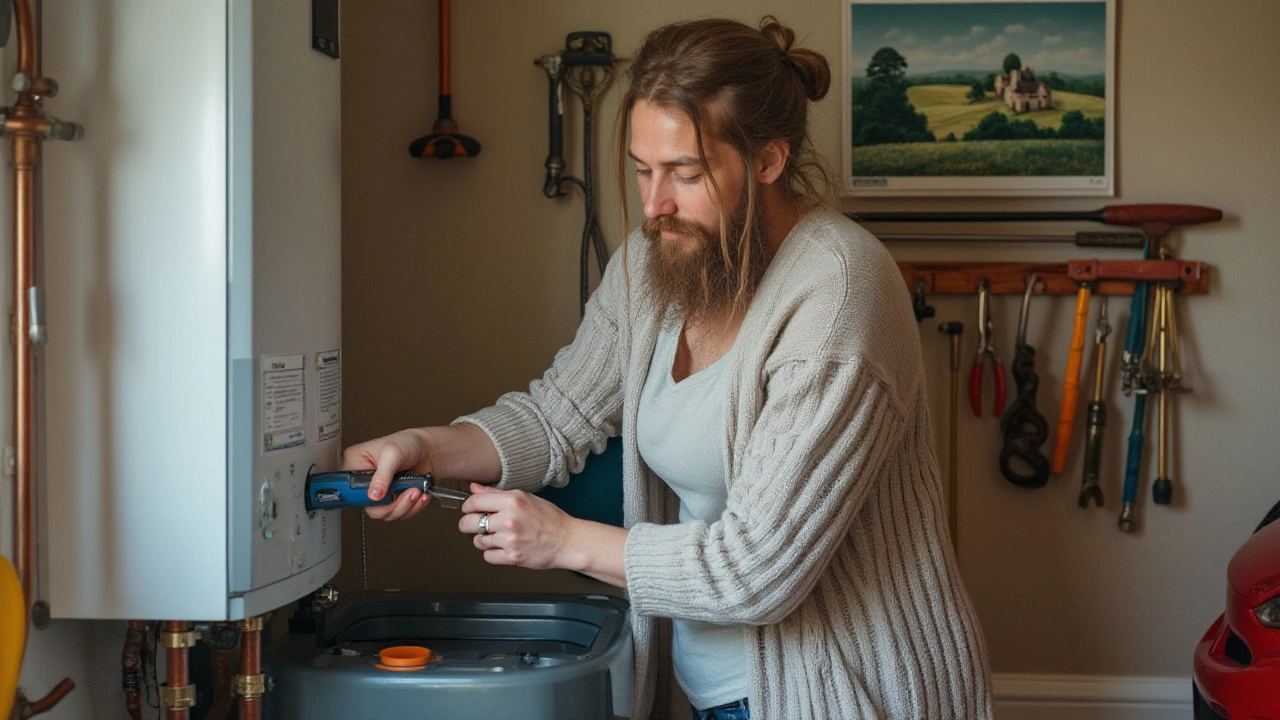
Maintenance Tips for a Consistent Hot Water Supply
Warm showers form a cozy cornerstone of daily life, making the agony of an unexpected cold splash all the more unwelcome. Keeping your hot water flowing smoothly isn't as daunting as it might seem, and a few proactive measures can go a long way. Routine maintenance is akin to giving your water heater a health check-up, ensuring it performs optimally throughout its life. Start by checking the thermostat settings every few months. For a hearty performance, set it between 50 to 60 degrees Celsius. This range not only prevents accidental scalding, especially for children or older adults, but also promotes energy efficiency, easing the burden on power bills.
One crucial element of maintenance is regularly flushing your water heater tank. Sediment build-up is an inevitable affair with time, particularly if you're in an area with hard water. Accumulated sediment can blanket the heater's components, making them work harder or potentially even causing damage. So, aim to flush the tank once a year. Doing so helps clear deposits and might even address those troubling cooling spells during showers. A simple method involves turning off the electricity or gas supply, attaching a hose to the drain valve, and allowing water to drain into a suitable location. This act might seem small, but it contributes immensely to a durable heater performance.
It's not just the tank that needs attention. Consider regular visual inspections of the entire system. Check the piping for any leaks, particularly around fittings and joints where weak points often develop. Leaks, however minor, can lead to inconsistent water temperatures or even costlier water damage over time. Tightening the pipe connections periodically or using sealant tape can often address these issues. While inspecting, check the venting system of your unit. A blockage or leak in the vent can impact how effectively your heater performs, so ensure that the path is clear and well sealed. "Proper maintenance is key to extending the life of your water heater and ensuring it performs efficiently," notes an expert from a respected plumbing institution. These words speak volumes about the importance of regular care.
Aside from physical inspections, pay attention to the way your heater sounds. Unusual noises like popping or cracking can indicate sediment build-up or other issues. Addressing these sounds sooner rather than later will often prevent larger problems from emerging. If your heater uses an anode rod to avoid corrosion, it’s a good idea to replace it every three to five years. These elements attract corrosive agents, safeguarding the vital components of your heater. An anode check is a simple task involving unscrewing the rod from the top of your unit. If it's less than 1.3 centimeters thick or severely corroded, it’s time for a new one.
Like any household fixture, your water heater requires a bit of love and care to function smoothly. By incorporating these maintenance elements into your regular household routine, you can ensure a steady and reliable supply of hot water. It’s not just about avoiding those dreaded cold shocks; regular maintenance is an investment in energy efficiency and long-term savings. After all, a little preventative effort now can spare you from costly repairs or replacements in the future, and what's more, let's you enjoy the uninterrupted comfort of warm showers whenever you please.

